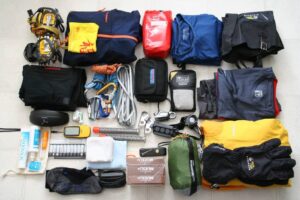
Hiker Information
Note: The following information may be preceded by the NVHC COVID-19 Guidelines.
Useful Links:
Hike Rating Guide
Directions to Meeting Locations
Policies
Directions to Trailheads
Catalog of Selected Past Hikes
Hike Preparation
To fully enjoy a hike, it’s important that you’re well prepared. The first step is selecting a hike that is currently being offered by one of our hike leaders. To view the hike opportunities offered by the club you may want to review our catalog of past hikes.
We recommend that you do not hike if you answer no to any of the five following questions:
1. Are you medically fit to participate in this event?
2. Have you recently done a hike of similar difficulty?
The hike rating may not always be accurate. Also, different people react differently to elevation change. Therefore, the rating is to be used only as a guide, along with other information, such as the actual distance and the amount of climbing, terrain, stream crossings, rock scrambles. If you have not hiked in the recent past, try an easy hike (rated D) first, and gradually work your way up. We recommend that you do not try a hike of a given rating unless you’re comfortable with hikes one rating lower (except for hikes rated D). For instance, do not attempt a B hike unless you have done some C hikes and feel confident about tackling something more challenging.
3. Do you have enough food and water?
We recommend that you carry two quarts of water. If the weather is hot, you will need even more water. Drink plenty of water. It helps you stay cool in summer and warm in winter. We recommend that you bring enough food depending on the length of the hike. Bring more than you need, just in case.
4. Do you have proper footwear?
We recommend hiking boots on all our hikes. The boots should be well broken in, and should preferably be waterproof. Buy from a well-known outfitter. While considering size, remember that feet expand after hiking; also, you may wear two layers of socks during winter. Try them before buying, with the socks you intend to wear during the hike. Consider gaiters for snowy hikes.
5. Do you have proper clothing?
For wet weather we recommend appropriate rain gear. For cold weather we recommend layered clothing. Cold weather clothing should exclude cotton and include the following:
- Long underwear that “wicks” moisture from body such as silk, polypropylene, or polyester
- Wool or fleece sweater or jacket
- Two pairs of socks: Synthetic inner layer, and wool or blend for the outer layer—avoid cotton
- Waterproof gloves or mittens
- Wool or fleece hat, preferably with flaps to cover your ears

 Meetup RSVP Etiquette
Meetup RSVP Etiquette
If you are wait listed, your chances of going are quite high; wait lists often dissipate quickly as the date of the hike approaches.
We request your assistance in reducing hike no-shows and minimizing wait lists by observing the following guidelines:
- If you RSVP yes to a hike, change your RSVP to no as soon as you find out that you will not be attending. Please do not wait until the last minute if you can avoid it.
- If you RSVP yes to multiple hikes on the same day with overlapping times, change one of your RSVPs to no as soon as you decide on which hike to attend.
- If you are on a wait list and no longer wish to attend, remove yourself from the wait list.
- If for some reason you do not get a chance to change your RSVP at the last minute either 1) send a direct message through Meetup to the leader or 2) post it in the comment section or 3) text or call the leader.
We appreciate your continued support and hope to see you on the trails soon.
 What to Bring on Hikes
What to Bring on Hikes
Here are some suggestions for items that will enhance your comfort on hikes. Bring any other items you may need. Keep the season in mind, and use your judgment.
- Enough food and water
- Cap with visor to prevent sunburn and glare
- Sunscreen
- Sunglasses
- Insect repellent spray
- Flashlight with batteries
- Matches kept in a dry bag
- First aid kit
- Extra shirt and socks stored in a dry bag
- Map to enable driving to the trailhead
- Trail map, preferably a topographical map
- Compass, with a knowledge of how to use one
- Whistle
- Toilet paper
- Extra set of car keys
Liability Disclaimer
You are responsible for your own safety on hikes with the Club. As unpaid volunteers, the hike leaders should not be relied on for any special skills. When you join the Club, you’ll sign a liability disclaimer: